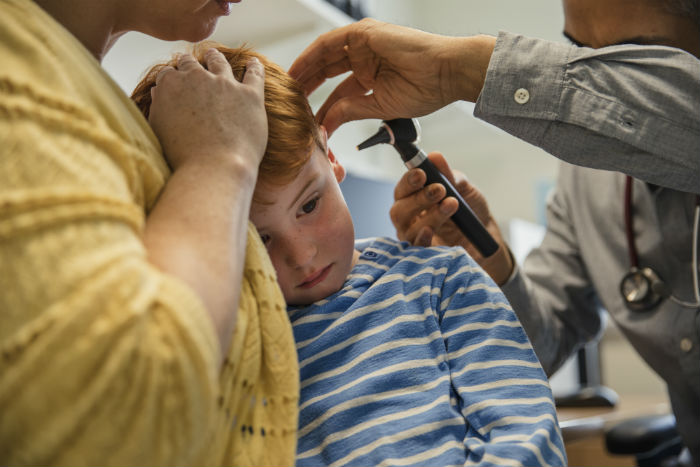Treatment
Pediatric Myringotomy Tubes (Ear Tubes)
Key points about pediatric myringotomy tubes
- Ear tubes – also known as myringotomy tubes, tympanostomy tubes or ventilation tubes – are small tubes that are surgically placed into your child's eardrum by an ear, nose and throat (ENT) surgeon to help drain the fluid out of your child’s middle ear.
- Children between ages 1 to 3 years old are most likely to need tubes.
- Your child's behavior, sleep and communication may be better if ear infections were causing problems after getting ear tubes inserted.
- Getting ear tubes inserted is normally an outpatient procedure. This means that your child will have surgery and then go home that same day.
- The ear tubes normally fall out in about six months to a year.
Frequently Asked Questions
What are ear tubes?
Ear tubes – also known as myringotomy tubes, tympanostomy tubes or ventilation tubes – are small tubes that are surgically placed into your child's eardrum by an ear, nose and throat (ENT) surgeon to help drain the fluid out of your child’s middle ear. These tubes, which are made of plastic, metal or other material, help reduce the risk for ear infections.
During an ear infection, fluid builds up in your child’s middle ear. This can affect your child's hearing. Sometimes even after the infection is gone, fluid may stay in the ear. These tubes help drain this fluid and hold off repeat fluid build-up.
Children between ages 1 to 3 years old are most likely to need tubes. By 5 years old, most children have wider and longer eustachian tubes (the canals that link the middle ear with the back of the nose). This lets fluid drain better from the ears.
Why might my child need ear tubes?
Your child’s healthcare provider may suggest tubes if your child has:
- Fluid in both ears for three or more months and hearing problems
- Fluid in one or both ears for three or more months and problems related to having fluid. These issues may include trouble with balance, ear pain, problems in school or with behavior and frequent ear infections
- Changes in the actual structure of the eardrum from ear infections
- A delay in speaking
- Repeated ear infections that do not improve with antibiotics over several months
What are the benefits of ear tubes?
- Ear tubes may lower your child’s risk for ear infections
- Your child’s hearing may get better
- Your child’s speech development won’t be affected
- The eustachian tubes can work better
- Your child's behavior, sleep and communication may be better if ear infections were causing problems
What are the risks of ear tubes?
The following are some of the risks of tubes:
- Some children with ear tubes still get ear infections.
- Some children may get an infection from the tubes.
- Sometimes the tubes leave a small hole in the eardrum after they come out. Your child may need surgery to fix this hole.
How long the tubes stay in can be a problem:
- The tubes should fall out in about one year. If your child gets ear infections after the tubes fall out, the tubes may need to be replaced.
- If the tubes stay in your child’s ear too long, a surgeon may need to remove them.
- After the tubes are removed, they may leave a small scar in the eardrum. This may cause some hearing loss.
How do I prepare my child for ear tube insertion?
Tell the surgeon about any medicines your child takes. This includes prescription medicines, over-the-counter medicines, vitamins, herbs and other supplements.
In an age-appropriate way, tell your child what is going to happen. Use short and simple words to describe the procedure. Tell them why it is being done. Younger children tend to have a short attention span. So talk with them shortly before the surgery. Older children can have more time to understand the procedure in advance. Answer any questions your child may have in a concrete, clear manner. Stress the positive changes that will occur because of the tubes.
Getting ear tubes inserted is normally an outpatient procedure. This means that your child will have surgery, and then go home that same day. Before the surgery, you'll meet with members of your child’s healthcare team. These people may include:
- Nurses. Nurses help your child get ready for surgery. Surgical nurses help the surgeon during the procedure. Recovery room nurses (or post-anesthesia care unit nurses) care for your child as he or she recovers from general anesthesia.
- Surgeon. This specialist places the tubes in your child’s ear.
- Anesthesiologist or nurse anesthetist. This specialist gives sleep medicine (anesthesia) and watches your child during surgery. Follow any directions your child is given for not eating or drinking before the surgery.
What happens during ear tube insertion?
Myringotomy is the surgical procedure that is performed to insert ear tubes. The surgery to place ear tubes in your child’s ear is called tympanostomy. It takes about 15 minutes. This procedure may include the following:
- Your child will receive general anesthesia. Your child’s healthcare team will watch him or her closely.
- The surgeon will make a small opening in your child’s eardrum. This is done to drain the fluid and relieve the pressure from the middle ear.
- The surgeon places a small tube in the opening of the eardrum. This lets air flow into the middle ear. It also keeps fluid from building up.
What happens after ear tube insertion?
Your child's hearing is restored after the fluid is drained. The tubes usually fall out on their own after six to twelve months. Your child's recovery will be monitored closely.
Most children can go home 1-2 hours after surgery. Your child will need follow-up care from his or her surgeon. The ear tubes normally fall out in about six months to a year. You’ll get instructions on how to care for your child’s tubes. Your child may need to use ear drops and he or she may also need to wear ear plugs in the bath or when swimming.
Call your child's healthcare provider if you have questions or if your child has any of the following symptoms:
- Drainage from the ear that lasts more than a few days after surgery or more drainage from the ears
- Ear pain
- Fever
- Ear tube that falls out
Providers of Myringotomy Tubes

Nancy M. Bauman, MD
- Director, Aerodigestive Clinic
- Director Vascular Anomaly Clinic
- Otolaryngologist
Nancy M. Bauman, MD
Locations
Departments

Alexandra Genevieve Espinel, MD
- Director, Pediatric Otolaryngology Fellowship
- Otolaryngologist
Alexandra Genevieve Espinel, MD
Locations
Departments
Pamela Anne Mudd, MD
Locations
Departments

Maria T. Pena, MD
- Director, Quality Improvement and Safety
- Co-Director, Complex Sinusitis Program
- Otolaryngologist
Maria T. Pena, MD
Locations
Departments

Diego A. Preciado, MD, PhD
- Division Chief, Ear, Nose, and Throat (Otolaryngology)
- Co-Director of the Cochlear Implant Program
- Otolaryngologist
Diego A. Preciado, MD, PhD
Locations
Departments
Brian Kip Reilly, MD
Locations
Departments

Rahul K. Shah, MD, MBA
- Senior Vice President for the Children’s National Hospital-Based Specialties Center
- Otolaryngologist
Rahul K. Shah, MD, MBA
Locations
Departments
George H. Zalzal, MD
Locations
Departments
Habib Zalzal, MD
Locations
Departments
Jul 22, 2024
Helping Maddie to Live Life to the FullestMaddie is a lively, creative teen who loves to act. Research at Children's National Hospital helps to ensure that her rare disease doesn"t upstage her big theater plans or her love of life.
Jun 27, 2024
Convenient Care for CharlotteWhen Charlotte was a toddler, a respiratory illness led to a diagnosis of a rare and dangerous immune deficiency called ICF syndrome. A bone marrow transplant at age 5 at Children’s National helped save her life.
May 20, 2024
Omid Conquers Fear with MusicOmid never liked going to the dentist. Dr. Aleger changed that with a little trust, and his favorite tunes.
Departments that Offer Myringotomy Tubes

Ear, Nose and Throat (Otolaryngology)
Our pediatric otolaryngology experts diagnose and treat a wide range of pediatric ear, nose and throat disorders.








